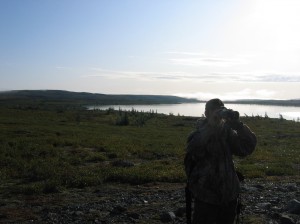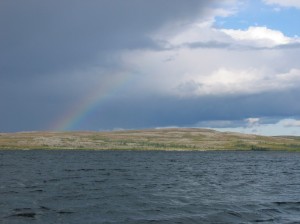 The flight to Camp Reále was punctuated with excited anticipation. The six of us exchanged stories, laughs, and got to know one another. We became good friends over the course of the coming days. It is likely that we will hunt with several of them again.
The flight to Camp Reále was punctuated with excited anticipation. The six of us exchanged stories, laughs, and got to know one another. We became good friends over the course of the coming days. It is likely that we will hunt with several of them again.
For some reason I thought that the tundra was going to be flat, treeless, uniquely beautiful, but desolate landscape. However, below the high set wings of the Otter, stretched never ending expanses of rolling and folding low green hills, grey igneous rocky ridges and outcroppings, and more water than I have seen on dry land anywhere, anytime.
It is not an exaggeration to say that in the typical section (a square mile) of tundra earth at least half of the surface was some type of water, creeks, huge rivers, lakes, ponds, swamps and bogs. We flew low above the ground scattering small herds of caribou which splashed in glistening shimmers across the soggy terrain. We saw the occasional bear which invariably reared back on its hind legs, swiping a stubby forepaw at us as if in attempt to swat a far off bee.
Camp Reále was a lonely scattering of four ramshackle shacks. The largest was the bunk house. It could not have measured more than 20X24. The camp sat on the edge of a wide place in a river at least six hundred miles from the nearest road. Power was by propane generator. This explained the explosive cylinder companions which shared the flight with us. We quickly learned that the generators came on at six in the morning and went off at ten at night.
Within minutes of bumping and lurching across the boggy field with it’s two track ruts that served as a runway we had disembarked from the Otter, unloaded and packed our gear into the bunk house. The camp crew was great, but complete characters. More on them in upcoming blogs in this series. (Get ready to smile!).
We were in the process of storing our gear in the bunk house when one of the guides ran in. With excited gestures he shouted, “Caribou, Caribou, Caribou, across the river”.
Imagine an accent that was a verbal soup of a curious cross of French Canadian, Nunavik Indian and Eskimo. We piled from the bunkhouse and scrambled down to the rivers edge with binoculars. Several hundred caribou were indeed moving north to south on the low ridges almost a mile across the water. The entire scene was magically back dropped by the pale prismatic arch of a tundra rainbow.
There looked to be some good bulls. Everyone began to run to collect their weapons. The bedlam transitioned to stunned disbelief when we found that the Otter had only carried part of our gear due to weight concerns. The two bow hunters had their bows, and a couple hunters had their guns, but the bags with the ammo and arrows were on the next plane in, whenever that might be.
 Our guide, Kerry nonchalantly reassured us in his unique dialect, “Happens sometimes. A couple of weeks ago we got socked in with weather and the plane could not come in for five days”. He flashed a genuine empathetic, mostly toothless grin.
Our guide, Kerry nonchalantly reassured us in his unique dialect, “Happens sometimes. A couple of weeks ago we got socked in with weather and the plane could not come in for five days”. He flashed a genuine empathetic, mostly toothless grin.
Steve, from Massachusetts, found a few arrows in his bow case. I have been on similar hunting expeditions before. Not all of my ammo was in the other gear bag. I gave myself a mental pat on the back as I clawed my cartridge belt out of my duffle. It held what had become a very valuable five cartridges in its leather loops. Rhett talked the camp manager, Ralph, out of the solitary camp rifle. Rhett cast a shocked expression my way when Ralph handed him the gun. It was a 1930’s .303 English Enfield with more rust than blue steel. There was one half box of ammo for it.
The guide chuckled at Rhett’s obvious concern, “That rifle kills bear, I guarantee it!”
To be continued…..